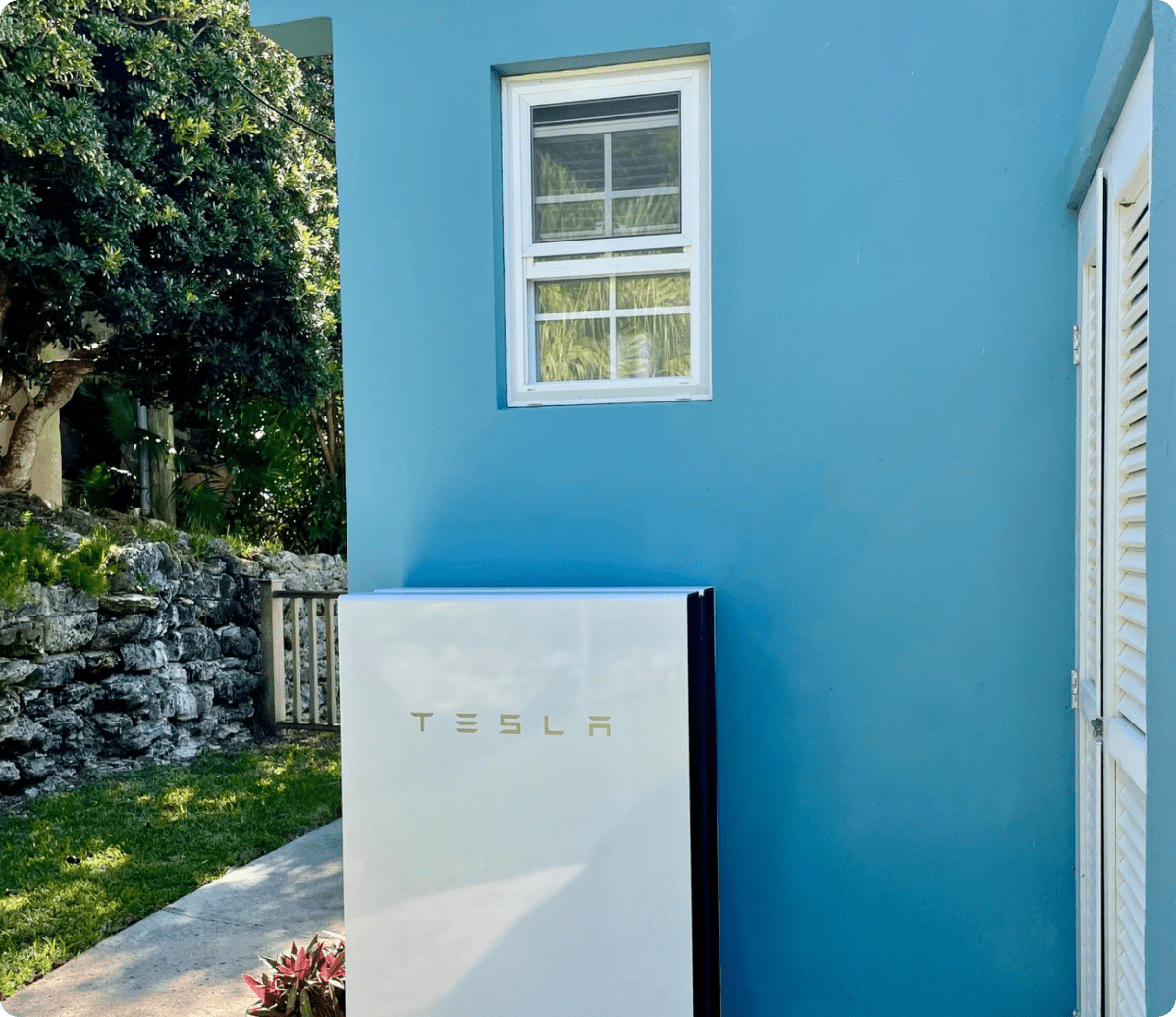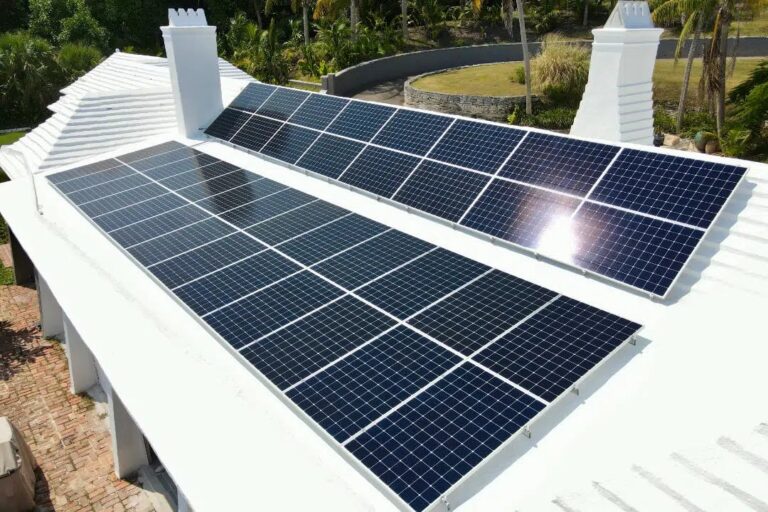Imagine securing your property, shuttering up your house and then hunkering down for a hurricane knowing you can remain cool and entertained, as well as use your fridge, freezer, oven and shower as normal — even if there is a power cut in your area.
With solar panels and battery storage, this is possible, said Cameron Smith, co-owner of Greenlight Energy. “It’s perfectly seamless,” he said. “It clicks in, in 100 milliseconds. You don’t even see a light flicker.”
How exactly does this work? And how many batteries do you need?
“Eighty per cent of our clients get two Powerwalls,” he answered, referring to the Tesla Powerwall rechargeable battery system installed by Greenlight Energy. “That is 27 kilowatt hours (kWh) of storage, and 10 kilowatts continuous.”
 What does that mean from a practical standpoint? “27 kWhs is enough to run the typical home overnight,” he explained. “As long as you’re not running it on something like 64 degrees Fahrenheit and running it on something more palatable, like 72F or 74F, you’ll get through the night with one or two air-conditioners on. Your fridge will be powered. Your wi-fi router will stay on. You can turn on all your LED lights. You can take a shower.”
What does that mean from a practical standpoint? “27 kWhs is enough to run the typical home overnight,” he explained. “As long as you’re not running it on something like 64 degrees Fahrenheit and running it on something more palatable, like 72F or 74F, you’ll get through the night with one or two air-conditioners on. Your fridge will be powered. Your wi-fi router will stay on. You can turn on all your LED lights. You can take a shower.”
Along with the Powerwall is a box called the Tesla Gateway, which is a “smart automatic transfer switch”. As soon as it detects a grid outage, it switches the source of power for your house to the batteries.
Unlike generators, the batteries are completely silent and have no moving parts, reducing the need for maintenance.
In order to generate the power however, you need solar panels. These can be installed anywhere on the property, but are usually fixed to the roof. What are the chances, therefore, of them blowing off during a hurricane? “The bolting method we use is rated for 150 mph winds. We’ve never lost a solar panel in a hurricane,” he answered confidently.
Furthermore, as long as the solar panels and batteries have been correctly installed, they can be included in that property’s insurance policy.
Solar panels and battery storage systems are a big investment, but they are not just for hurricanes. They can also help to reduce your Belco bill all year round.
On their own, solar panels will generate power as long as the sun is shining. However, on a cloudy day, it will generate less power, and when the sun goes down, no power. This is where the battery storage system comes into play.
“When you get solar panels, you can intuit their effectiveness over the course of a typical day,” said Mr Smith. “Around midday, when the sun is highest in the sky, the solar panels are producing the most power, however the sunlight doesn’t correlate perfectly with usage habits.
“Typically, when the solar panels are producing the most power, homeowners are using the least amount of power because they’re not home. The answer to that would be energy storage, which stores any energy that’s being produced [during the day], so it can be used during the higher energy usage times, which is typically in the evenings around 6pm when everybody gets home and the air-conditioner’s turned on, the ovens go on and the kettle’s running.”
The Tesla app allows you to see how much power your panels are generating, and when. You can also manage how you use your stored energy. If, for example, you always want to keep 30 per cent in reserve in case of an unexpected outage, you can use the app to set that up. In that case, the house will switch back to the grid when the battery storage gets down to 30 percent. As soon as the sun comes out again, the battery recharges.
The reserve setting can be changed at any time. When you know a hurricane is coming, you might want to keep your battery fully charged to guarantee full capacity when the grid goes down. Should you need to, you can also charge the battery from the grid.
Steve Thomson, father of Greenlight president Kenneth Thomson, was one of their first customers. He loves the app: “I can change the batteries so, say a hurricane’s coming, [I can] keep my battery stocked up to 100 percent rather than using them overnight. And, I can say ‘oh it’s night time now, we’ve got a hurricane tomorrow morning, let me let Belco charge the batteries’. I can change it so they can charge it.”
Mr Thomson had 38 panels installed on his roof and three batteries in his basement about four years ago and, in addition to being able to “enjoy” hurricanes in comfort, he has seen his Belco bills drop dramatically. He lives in a two-bedroom house on South Shore in Warwick which also has a one-bedroom cottage and a swimming pool.
“I used to pay $1,600 to $1,700 a month in the summer,” he said, adding: “Now, in April, May and June, I’ll pay the facilities fee, I might pay $80 or $100 and in the summer, when I’m using a lot of air-conditioning, maybe my bill is $250 or $300 maximum. It makes a big difference.”
While the Belco savings might be substantial, the up-front cost of having a solar energy system installed is significant, but explained Mr Smith, it will pay for itself in the longer run.
For the solar panels, the cheapest system Greenlight has installed has been $18,000 and the most expensive was $300,000. For a monthly Belco bill of $600, Mr Smith estimated needing a number of panels that would cost between $30,000 – $50,000 depending on the complexity of the installation. While there are many variables involved, he estimated you would earn that back in around six to eight years.
For batteries, the first one costs around $20,000, again depending on factors such as the complexity of installation, but, once installed, additional batteries may not cost quite as much, because the complicated installation work is done.
The solar panels come with a 25-year warranty and the Tesla Powerwall with a ten-year warranty.

